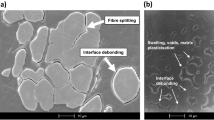Abstract
The damage effects of water sorption on the mechanical properties of the hydroxyapatite particle reinforced Bis-GMA/TEGDMA copolymer (HA/Bis-GMA/TEGDMA) have been predicted using 3D finite cell models. The plasticizer effect on the polymer matrix was considered as a variation of its Young’s modulus. Three different cell models were used to determine the influence of varying particle contents, interphase strength and moisture concentration on the debonding damage. The stress distribution pattern has been examined and the stress transfer mode clarified. The Young’s modulus and fracture strength of the Bis-GMA/TEGDMA composite were also predicted using the model with and without consideration of the damage. The former results with consideration of the debonding damage are in good agreement with existing literature experimental data. The shielding effect of our proposed model and an alternative approach were discussed. The FCC cell model has also been extended to predict the critical load for the damaged and the undamaged composite subject to the 3-point flexural test.
Similar content being viewed by others
References
Sideridou, I., Tserki, V. and Papanastasiou, G., Study of water sorption, solubility and modulus of elasticity of light-cured dimethacrylate-based dental resins. Biomaterials, 2003, Vol.24, 655–665.
Sideridou, I., Tserki, V. and Papanastasiou, G., Effect of chemical structure on degree of conversion in light-cured dimethacrylate-based dental resins. Biomaterials, 2002, Vol.23, 1819–1829.
Fan, P.L., Edahl, A., Leung, R.L. and Stanford, J.W., Alternative interpretations of water sorption values of composite resins. J Dent Res, 1985, Vol.64, 78–80.
Santos, C., Clarke, R.L., Bradenb, M., Guitian, F. and Davy, K.W.M., Water absorption characteristics of dental composites incorporating hydroxyapatite filler. Biomaterials, 2002, Vol.23, 1897–1904
Lee, M.C. and Peppas, N.A., Hydrothermal fatigue on interface of glass-epoxy laminates. Journal of Composite Materials, 1993, Vol.27, 1146–1149.
Ferracane, J.L., Berge, H.X. and Condon, J.R., In vitro aging of dental composites in water-Effect of degree of conversion, filler volume, and filler/matrix coupling. J BIOMED MATER RES, 1998, Vol.42, 465–472.
Asaoka, K. and Hirano, S., Diffusion coefficient of water through dental composite resin. Biomaterials, 2003, Vol.24, 975–979.
Cattani-Lorente, M.A., Dupuis, V., Payan, J., Moya, F. and Meyer, J.M., Effect of water on the physical properties of resin-modified glass ionomer cements. Dental Materials, 1999, Vol.15, 71–78
Lee, S.Y., Chiang, H.C., Lin, C.T., Huang, H.M. and Dong, D.R., Finite element analysis of thermo-debonding mechanism in dental composites. Biomaterials, 2000, Vol.21, 1315–1326
Lee, S.Y., Chiang, H.C. and Huang, H.M., et al., Thermo-debonding mechanisms in dentin bonding systems using finite element analysis. Biomaterials, 2001, Vol.22, 113–123
Ensaff, H., O’Doherty, D.M. and Jacobsen, P.H., The influence of the restoration-tooth interface in light cured composite restorations: a finite element analysis. Biomaterials, 2001, Vol.22, 3097–3103.
Palamara, D., Palamara, J.E.A., Tyas, M.J. and Messer, H.H., Strain patterns in cervical enamel of teeth subjected to occlusal loading. Dental Materials, 2000, Vol.16, 412–419.
Ausiello, P., Apicella, A., Davidson, C.L. and Rengo, S., 3D-finite element analyses of cusp movements in a human upper premolar, restored with adhesive resin-based composites. Journal of Biomechanics, 2001, Vol.34, 1269–1277.
Ausiello, P., Apicella, A. and Davidson, C.L., Effect of adhesive layer properties on stress distribution in composite restoration — a 3D finite element analysis, Dental Materials, 2002, Vol.18, 295–303.
Sankarapandian, M., Shobba, H.K., Kalachandra, S., McGrath, J.E. and Taylor, D.F., Characterization of some aromatic dimethacrylates for dental composite applications. J Mater Sci: Mater Med, 1997, Vol.8, 465–468.
Asmussen, E. and Peutzfeldt, A., Influence of UEDMA, Bis-GMA and TEGDMA on selected mechanical properties of experimental resin composites. Dental Materials, 1998, Vol.14, 51–56.
Leinfelder, K.F., Composite resins. Dent Clin North Am, 1985, Vol.29, 359–371.
Willems, G., Lambrechts, P., Braem, M., Celis, J.P. and Vanherle, G., A classification of dental composites according to their morphological and mechanical characteristics. Dent Mater, 1992, Vol.8, 310–319.
Gladys, S., Van Meerbeek, B., Braem, M., Lambrechts, P. and Vanherle, G., Comparative physico-mechanical characterization of new hybrid restorative materials with conventional glass-ionomer and resin composite restorative materials. J Dent Res, 1997, Vol.76, 883–894.
Labella, R., Braden, M. and Deb, S., Novel hydroxyapatite-based dental composites. Biomaterials, 1994, Vol.15, 1197–1200.
Murray, D.G., Hydroxylapatite-synthetic resin composites. USA Patent 4778834, 1988.
Dickens-Venz, S.H., Takagi, S., Chow, L.C., Bowen, R.L., Johnston, A.D. and Dickens, B., Physical and chemical properties of resin-reinforced calcium phosphate cements. Dental Materials, 1994, Vol.10, 100–106.
Domingo, C., Arcís, R.W., Osorio, E., Osorio, R., Fanovich, M.A., Rodriguez-Clemente, R. and Toledano, M., Hydrolytic stability of experimental hydroxyapatite-filled dental composite materials. Dental Materials, 2003, Vol.19, 478–486
Plueddemann, E.P., Silane Coupling Agents. New York: Plenum Press, 1982, 139–159.
Söderholm, K.J., Influence of silane treatment and filler fraction on thermal expansion of composite resins. J Dent Res, 1984, Vol.63, 1321–1326.
Lee, C.T., Lee, S.Y., Keh, E.S. and Dong, D.R., Influence of silanization and filler fraction on aged dental composites. J ORAL REHABIL, 2000, Vol.27, 919–926.
Author information
Authors and Affiliations
Corresponding author
Additional information
Project supported by the Research Committee of the Hong Kong Polytechnic University (No.G-U042).
Rights and permissions
About this article
Cite this article
Fan, J., Tsui, C.P., Tang, C.Y. et al. 3D finite element analysis of the damage effects on the dental composite subject to water sorption. Acta Mech. Solida Sin. 19, 212–222 (2006). https://doi.org/10.1007/s10338-006-0626-4
Received:
Revised:
Published:
Issue Date:
DOI: https://doi.org/10.1007/s10338-006-0626-4




